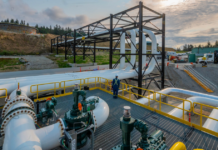As Alberta grappled with a cold snap that resulted in a province-wide Emergency Alert, Saskatchewan’s crucial intervention played a pivotal role in averting a critical energy crisis.
Saskatchewan Premier Scott Moe confirmed in a post to X Saturday night that Saskatchewan was providing 153MW of electricity to Alberta to assist them through the evening.
“That power will be coming from natural gas and coal-fired plants, the ones the Trudeau government is telling us to shut down (which we won’t),” said Moe.
On Saturday, the Alberta Emergency Management Agency issued an alert, warning residents that the extreme cold has resulted in high power demand and placed the province’s grid at high risk of rotating power outages.
The Emergency Alert sent to Albertans’ mobile devices throughout the province asked residents to limit their electricity use to essential needs only.
Alberta’s Minister of Energy, Nathan Neudorf, said in an interview with True North that the province is incredibly grateful that Saskatchewan stepped up and provided Alberta with 153MW of energy when the province needed it most.
Neudorf said that without Saskatchewan’s help, Alberta’s load would have exceeded its generation; this would have caused rolling brownouts.
“At those temperatures, even an hour or two without power would have resulted in significant consequences,” said Neudorf.
The risks and consequences would have been serious. -40°C temperatures, not including windchill, would result in freezing water lines and people trying to heat their homes in unconventional ways — which could lead to fires, and extreme frostbite would set in very quickly, said Neudorf.
There have been no rotating outages in 11 years, said Leif Sollid, spokesperson for the Alberta Electric System Operator (AESO), according to The Globe and Mail. The province would have had to implement 30-minute rotating outages across the province had it not been for Albertans’ response.
“Within seconds, we saw 100 megawatts of demand fall off the system. Within a few minutes, we had 200 megawatts fall off,” said Sollid. “Within seconds, we could see in real-time in our control room the demand just drop and it was phenomenal. A huge shout-out to Albertans for doing their part.”
While thankful for Saskatchewan’s helping hand, Minister Neudorf also emphasized that Alberta stands in solidarity with Saskatchewan against Ottawa’s proposed clean energy regulations.
“This is a perfect case in point that at certain times during the year, particularly in winter at very cold temperatures, the reality of a northern-based climate is: we need dispatchable energy there when we need to call upon it,” said Neudorf.
He added that no solar was available, given that it was after sunset. He said it was either too cold to generate wind, or there was no wind during the weekend.
Martyupnorth, an Albertan commentator on X, analyzed Alberta’s power consumption from data on the AESO website. He showed that Alberta has 20,777 MW of installed and approved power generation. Of that, 2,400MW was under construction or commissioning on Sunday morning when he posted the data.
Wind and solar power account for 6,132MW (29.5%) of the capacity. On Sunday morning, wind and solar delivered 32MW of power or 0.29% of the 10,958MW being consumed by Alberta at that time.
He said that 6,115MW of wind and solar power generation were frozen.
While Saskatchewan was extremely helpful to Alberta, so too were Albertan citizens. Premier Danielle Smith thanked Albertans in a post to X for responding to the government’s call to reduce electrical consumption where possible.
“The swift and impactful actions led to a remarkable 200MW reduction in demand, averting the need for rotating power outages,” she said.
Alberta has begun inquiries into the balance and mix of its power generation so that it can better plan for a future where sustainability, reliability, and affordability are key to the province’s power generation mix.





















